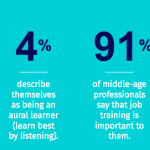Roughly 86% of employees say that job training is important to them—and nearly three out of every four (74%) are willing to learn things outside of work hours to improve their job performance.
Why do employees value job training so much? And are employers doing enough to satisfy their appetite?
To help unpack the answers to these questions, we surveyed 666 employees on SurveyMonkey Audience. We asked workers about their learning experiences both with their employer and outside of work.
Eager to see the results? Don’t worry, we’ll train you up on what we’ve learned.
What are you curious about?
SurveyMonkey Audience can help you get answers directly from your target market.
Training inspires employees to do better work
Employees' direct benefits from job training can help explain their enthusiasm for pursuing it.
Here are just a few of the career improvements they attribute to their training:
- 59% say it improves their overall job performance.
- 51% believe it gives them more self-confidence.
- 41% claim it helps their time-management skills.
- 33% cite it as a factor in earning them a pay bump.
To continually experience these benefits, many (62%) stay up-to-date on current events in their field, more than half (51%) are willing to seek out advice from peers, family, and colleagues, and 38% are willing to take the time to attend conferences.
These career improvements predictably benefit employers. In fact, organizations that offer comprehensive training experience a 24% higher profit margin.
Despite the clear win-win situation, there’s a major gap in the training most companies offer and what their employees want to receive.
Related: How to keep good employees from leaving.
Employers miss major training opportunities
Only 52% of employees think their employer provides the right amount of training. Here are some reasons why:
1. Mentorship programs are often missing.
As mentioned earlier, 51% of employees already take the initiative to speak with people around them in order to improve at their job—a figure that balloons to 62% among young professionals (people 18-29 years old).
Despite employees’ desire for guidance and wisdom, about 1 in 3 of America’s most financially powerful organizations—those in the Fortune 500—don’t offer a formal mentorship program. That ratio rises substantially as businesses get smaller in scale. Roughly 75% of smaller companies don’t offer a mentorship program.
2. Many employers either don’t promote or provide online education.
More than 70% of employees either don't know if their employer offers access to online education platforms (e.g. Udemy, Udacity, or Coursera) or are confident that they don’t. Since 34% of employees already take online courses in their free time, it’s likely that many would take employers up on an offer of high-quality, free classes.
3. Tenured employees are being neglected.
Performing in-person training for new employees, or onboarding, is common among organizations. But as employees mature in the company, and the potential value they offer grows, opportunities for guidance and education become few and far between.
Why do employers cut back on training after employees settle in? Perhaps it’s their belief in the “culture of genius”—the idea that employees either have the natural talent to succeed or don’t. More than 1 in 5 employees say their employer believes in this concept that performance is based on talent alone, without room to grow, which ultimately ends up stifling improvement.
If your organization can step up and invest in more tenured workers, you’ll see a return both in your brand perception, and on employee productivity.
Just look at AT&T’s current initiative to retrain 100,000 of its employees. The company is offering resources like online courses to help employees learn increasingly relevant skills. The early results from the initiative? More than half of their employees have already taken courses and the company has earned a spot in Fortune 100’s best companies to work for for the first time.
So what can your organization do to help employees learn and grow?
Related:Could having a customer-centric culture lead to better employee engagement? New research shows that companies that put customers first are significantly more likely to have employees who find their jobs meaningful and plan to stay longer.
Understand employees’ wants and learning styles
Employees have a variety of ideas for improving their organization’s approach to training. Here’s what some of them had to say in our survey:
- “Provide continuing education programs at a convenient location.”
- “Develop a comprehensive learning plan with each employee.”
- “Let employees travel to conferences.”
Your team likely has their own ideas for what they need, and you should survey them to see what they might be interested in.
If you plan on providing the training in-house, consider the different ways to present your content:
- Employees cite watching videos most often (65%) when choosing how they like to learn. This is followed by lectures and presentations (55%), and reading short articles (47%).
- Employees’ least popular (25%) way to learn is listening to audio recordings.
- 74% of employees describe themselves as being either a visual (charts, graphs, and other visuals help them learn best) or a physical (physical activity helps them learn best) learner.
Is a video always the best way to educate your employees? Not necessarily. Can audio recordings help your workers learn? Sure they can. But these general preferences and opinions are a good baseline when reviewing different teaching methods.
The demand for employee learning presents managers and employers with a big opportunity. If done right, it gives your organization the chance to help employees grow, improve your brand image, and boost your bottom line. You just need to find out what your employees want to learn and how they want to learn it.
Curiosity Center
Want to see what else we learned? Here’s what employees told us:

Create your own stories based on data
Our content marketing guide will teach you everything you need to know about creating content based on original research from survey data.



